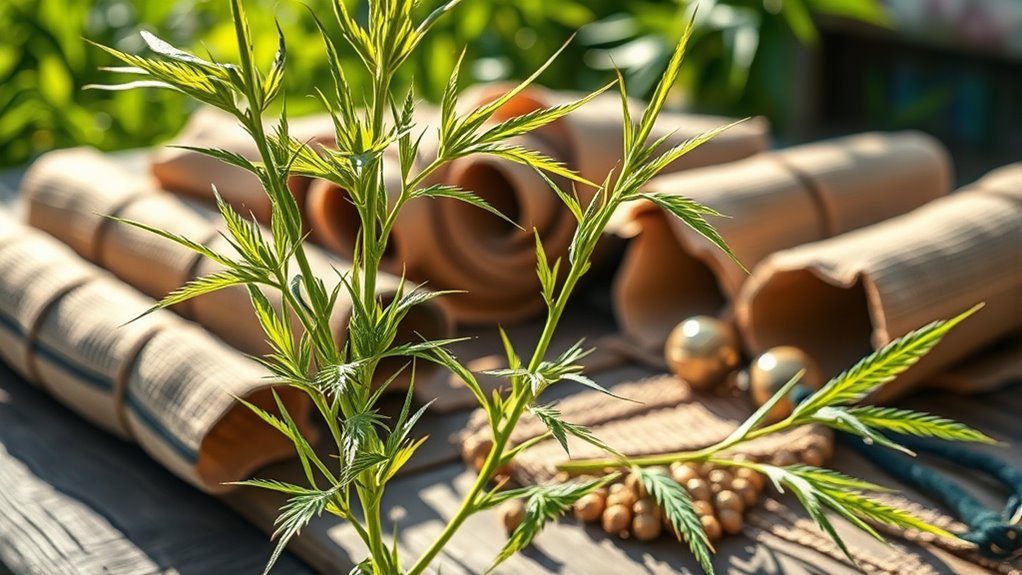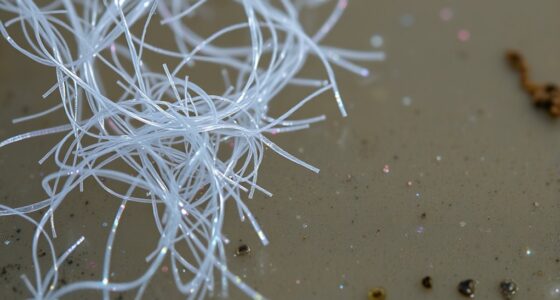Hemp is the dark horse of sustainable fashion because it offers major environmental benefits, like natural biodegradation, less water use, and pest resistance, reducing chemical reliance. It supports ethical sourcing and has a growing market influence, contributing billions globally. Its versatility allows for stylish, eco-friendly garments across all fashion levels, encouraging a shift toward greener choices. If you explore further, you’ll discover how hemp truly revolutionizes sustainable fashion from farm to wardrobe.
Key Takeaways
- Hemp’s rapid growth and low resource needs make it highly sustainable and environmentally friendly compared to traditional fibers.
- Its natural pest resistance reduces chemical pesticide use, supporting eco-conscious cultivation practices.
- Versatile for various fashion applications, hemp combines style with sustainability, appealing to eco-aware consumers.
- The economic influence of hemp in the global market promotes innovation and investment in sustainable fashion.
- Hemp’s ethical sourcing and minimal environmental impact position it as a revolutionary fiber in the fashion industry.

Have you ever wondered how fashion can be both stylish and eco-friendly? The answer lies in exploring materials like hemp, which is quickly gaining recognition as a dark-horse fiber of sustainable fashion. Hemp’s rise isn’t just about its durability or versatility; it’s about the positive impact it has on the environment and the ethical standards it upholds. When you choose hemp, you’re supporting a fiber that offers significant biodegradability benefits. Unlike synthetic fabrics that linger in landfills for centuries, hemp decomposes naturally, leaving no harmful residues behind. This quality makes it an excellent choice for those who want their fashion choices to minimize environmental harm. Additionally, hemp’s rapid growth cycle means it can be harvested multiple times a year without exhausting the soil, reducing the need for chemical fertilizers or pesticides. This ties directly into the concept of ethical sourcing, as hemp is cultivated in a way that respects both the environment and the communities involved in its production. Recent studies highlight that hemp also has a significant economic impact, contributing billions in revenue and attracting millions of viewers weekly, which underscores its growing influence in the global market.
Choosing hemp also aligns with a commitment to ethical sourcing. Hemp plants require less water than cotton and thrive without artificial inputs, making them a more sustainable crop overall. When you buy hemp-based garments, you’re supporting farming practices that are kinder to the planet. Many ethical brands prioritize transparency, ensuring their suppliers adhere to fair labor standards and environmentally conscious cultivation methods. This means your clothing isn’t just eco-friendly; it’s ethically produced too. Hemp’s versatility allows it to be spun into fibers suitable for a wide range of fashion items, from casual wear to high-end pieces, without sacrificing style or quality. Its natural resistance to pests reduces the need for harmful pesticides, further supporting the eco-friendly narrative.
In embracing hemp, you’re not only making a fashion statement but also advocating for a more sustainable industry. The environmental advantages—biodegradability benefits and reduced resource consumption—are compelling reasons to contemplate hemp as your go-to fiber. Plus, supporting brands that value ethical sourcing ensures your wardrobe aligns with your values. It’s about making smarter choices that promote a healthier planet and fairer labor practices. As more designers and consumers recognize hemp’s potential, it’s clear that this humble plant can revolutionize the way we think about sustainable fashion. So, next time you’re shopping for clothes, think about how hemp’s unique benefits can help you look good while doing good for the environment and the people involved in your clothing’s journey.
Frequently Asked Questions
How Does Hemp Compare to Organic Cotton in Sustainability?
When comparing hemp to organic cotton in sustainability, you’ll find hemp requires less water and chemical processing. Hemp grows quickly with minimal water and no pesticides, making it eco-friendly. Organic cotton, on the other hand, needs more water and often involves chemical treatments. So, if you’re aiming for a sustainable choice, hemp’s lower water use and reduced chemical processing make it a smarter, more eco-conscious fiber option.
Are Hemp Fabrics Suitable for All Clothing Types?
Hemp fabrics are versatile and suitable for many clothing types, but not all. You can use hemp dyeing to create vibrant, eco-friendly colors, and hemp blending with other fibers adds softness and durability. While perfect for casual wear, denim, or activewear, hemp may be less ideal for delicate or formal garments. Overall, its adaptability depends on how you incorporate hemp through dyeing and blending techniques.
What Are the Environmental Impacts of Hemp Cultivation?
Hemp cultivation has positive environmental impacts, especially regarding water usage and soil health. You’ll find that hemp requires relatively little water compared to other crops, making it more sustainable. Additionally, it helps improve soil health by reducing erosion and adding nutrients back into the soil. Growing hemp can also lower the need for chemical fertilizers and pesticides, making it an eco-friendly choice for sustainable farming practices.
How Affordable Is Hemp-Based Fashion Compared to Traditional Fabrics?
When you look at the cost comparison between hemp-based fashion and traditional fabrics, you’ll find hemp is generally more affordable in the long run. Its affordability analysis shows lower production costs and durability reduce expenses over time. Though initial prices may be slightly higher, the overall value and sustainability benefits make hemp garments a budget-friendly choice, especially as demand and supply increase, making them more accessible for consumers like you.
Can Hemp Be Easily Recycled or Biodegraded?
Think of hemp as a gift from nature, ready to return to the earth. You’ll find that hemp can be easily recycled through specialized processes, turning old fabrics into new fibers. Its biodegradation timeline is relatively quick—often within a few months—making it an eco-friendly choice. Recycling processes make hemp a sustainable star, ensuring it gracefully completes its lifecycle without harming the environment you cherish.
Conclusion
As you explore sustainable fashion, hemp stands out as a game-changer. Imagine a brand like Patagonia switching to hemp-based fabrics—reducing their environmental footprint while offering durable, stylish products. Hemp’s rapid growth, low water needs, and biodegradability make it the dark horse in eco-friendly textiles. By choosing hemp, you’re not just making a fashion statement, but supporting a greener future. So, next time you shop, consider hemp—your wardrobe and the planet will thank you.










